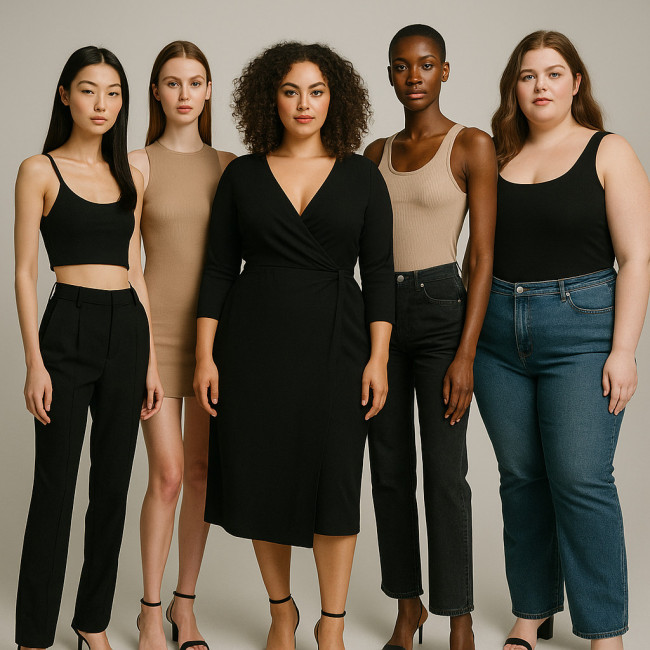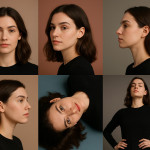Inclusive sizing tags lift diverse female models in recruiter searches
Inclusive sizing tags transform how female model profiles surface in talent directories. By adding precise body-measurement keywords—beyond the traditional “XS–XL” labels—you help algorithms match you to briefs faster, increase recruiter trust and widen representation on set.
Why inclusive sizing tags matter for female model visibility

From an algorithmic standpoint, the presence of clear measurements, fit descriptors and inclusivity keywords gives the search engine enough semantic and numeric variety to rank you confidently for multiple briefs. Equally important, casting professionals scanning dozens of thumbnails in grid view can glance at your qualifiers—“bust 36 in”, “curve”, “tall”—and know instantly you meet the spec. That clarity removes hesitation, speeds the shortlist phase and positions you as a reliable, data-rich candidate in a competitive market.
The recruiter perspective: speed and certainty
Fashion, advertising and e-commerce teams often work under 48-hour casting deadlines. They filter databases by exact bust, waist and hip ranges, fit category (petite, curvy, tall) and even garment conversion metrics (e.g. “UK 14 = US 10”). Profiles missing these inclusive sizing tags disappear from shortlists—even if the visuals are stunning.
Algorithms favour granular body data
Directory search engines reward detail. When you list both numeric measurements and plain-language tags such as “curve model”, “plus-size 1X”, or “tall 5 ft 11”, your profile gains relevance points. That boost pushes you above competitors who only publish a single clothing size.
Source : ModelMetrics Report 2024
Anatomy of high-performing inclusive sizing tags
| Tag element | Example | Why it boosts searches |
|---|---|---|
| Numeric range | “Bust 36 in – 92 cm” | Matches international briefs and auto-converts units. |
| Fit category | “Curve model / US 16 / EU 46” | Signals garment drape and sample size fast. |
| Proportion cue | “Long torso” or “Athletic legs” | Helps stylists select looks that flatter on camera. |
| Inclusivity keyword | “Body-positive”, “Adaptive-wear friendly” | Indexes your profile for campaigns with diversity KPIs. |
Where to place the tags for maximum impact
- Title field: Add one concise fit descriptor right after your name.
- Specialised tag section: Use the directory's dedicated “Measurements & sizes” module; repeat nothing elsewhere.
- Alt text on photos: Describe both the outfit and the inclusive size shown.
- Bio paragraph: Integrate natural keywords such as “I represent curvy sizes 14–16”.
Complementary profile tweaks that amplify sizing tags

Inclusive sizing tags work best alongside other search-centric optimisations. For sharper first-impression images explore photo angle tactics that increase click-through on thumbnail grids. Pair your tags with SEO-friendly bios so text relevance and body data reinforce one another. Remember that modern talent directories blend visual, textual and technical signals; when crisp portraits, keyword-rich captions and precise measurements all align, the algorithm reads your profile as an authoritative match and rewards it with premium placement in search results.
Recruiters also filter by location, age bracket and accessibility criteria. Adjust age fields with help from age-range filtering techniques, and ensure screen-reader descriptions meet WCAG guidelines using these screen-reader friendly profile layouts.
Step-by-step guide: adding inclusive sizing tags on Artfolio
- Log in and open your female model profile on the Artfolio female model directory.
- Navigate to “Measurements”. Enter bust, waist, hips and height in both imperial and metric units.
- Select all fit categories that apply: petite, curve, tall, athletic, maternity, adaptive.
- Add optional descriptors in the “Other sizes” free-text box (e.g. “Bra 38C”, “Shoe US 9 / EU 40”).
- Update alt text on gallery images: “Model wearing size 14 denim, 36-inch waist”.
- Save, then preview your public profile to confirm tags display cleanly on desktop and mobile.
Common mistakes to avoid
- Conflicting data: Listing “US 8” in one field and “EU 38” in another creates algorithm penalties.
- Using brand-specific size codes: “Zara L” means nothing to a recruiter outside that label.
- Keyword stuffing: Repeating “plus-size” ten times lowers readability scores and ranking.
- Ignoring updates: Gain muscle or lose inches? Refresh tags before the next casting cycle.
Success story: curve model lands three briefs in one week
A London-based curve model added inclusive sizing tags—UK 18, curve, long torso, adaptive wear—on Monday. By Friday she booked a lingerie e-commerce shoot, a sustainable denim campaign, and a body-positive fitness brand spot. Recruiters cited “exact size match” as the top reason for outreach.
Quick self-audit checklist
- Are numeric measurements visible in both inches and centimetres?
- Have you chosen all accurate fit categories?
- Does every gallery image show size context in caption or alt text?
- Is your bio readable at Grade 8 level, free from repeated jargon?
- Did you verify that tags display correctly on mobile search previews?
Mini-quiz: test your inclusive sizing savvy
FAQ
- Do inclusive sizing tags replace professional measurements?
- No. They complement agency-verified cards by making your profile discoverable before a casting director calls.
- Can petite models benefit from inclusive tagging?
- Absolutely. Tags like “petite 5 ft 2” or “sample size 0P” capture briefs seeking smaller fit models.
- How many sizing tags are too many?
- Stick to 4–6 precise tags. Beyond that, algorithms may flag spam and lower relevance.
- Will updating tags affect my existing rankings?
- You may drop for a day as the index refreshes, then climb higher once the new data scores.
- What if my body fluctuates seasonally?
- Update measurements quarterly and add a note in your bio: “Current as of May 2025”.
Take action now
Log in, add those inclusive sizing tags, and refresh your gallery captions today. You'll join the growing roster of diverse models landing briefs in record time—and stand out long before the next casting call.











